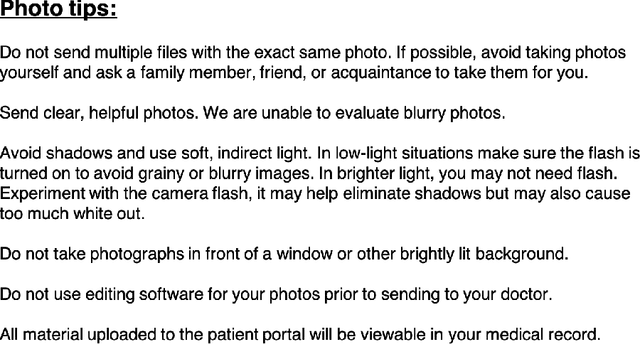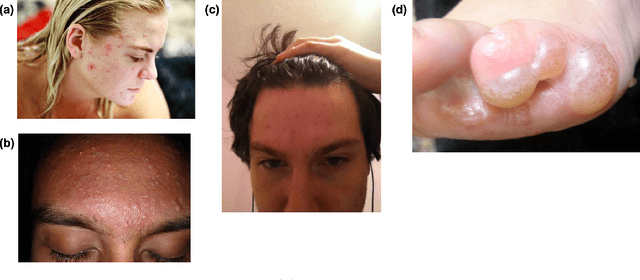Justin M Ko
Towards Realization of Augmented Intelligence in Dermatology: Advances and Future Directions
May 21, 2021Abstract:Artificial intelligence (AI) algorithms using deep learning have advanced the classification of skin disease images; however these algorithms have been mostly applied "in silico" and not validated clinically. Most dermatology AI algorithms perform binary classification tasks (e.g. malignancy versus benign lesions), but this task is not representative of dermatologists' diagnostic range. The American Academy of Dermatology Task Force on Augmented Intelligence published a position statement emphasizing the importance of clinical validation to create human-computer synergy, termed augmented intelligence (AuI). Liu et al's recent paper, "A deep learning system for differential diagnosis of skin diseases" represents a significant advancement of AI in dermatology, bringing it closer to clinical impact. However, significant issues must be addressed before this algorithm can be integrated into clinical workflow. These issues include accurate and equitable model development, defining and assessing appropriate clinical outcomes, and real-world integration.
TrueImage: A Machine Learning Algorithm to Improve the Quality of Telehealth Photos
Oct 01, 2020



Abstract:Telehealth is an increasingly critical component of the health care ecosystem, especially due to the COVID-19 pandemic. Rapid adoption of telehealth has exposed limitations in the existing infrastructure. In this paper, we study and highlight photo quality as a major challenge in the telehealth workflow. We focus on teledermatology, where photo quality is particularly important; the framework proposed here can be generalized to other health domains. For telemedicine, dermatologists request that patients submit images of their lesions for assessment. However, these images are often of insufficient quality to make a clinical diagnosis since patients do not have experience taking clinical photos. A clinician has to manually triage poor quality images and request new images to be submitted, leading to wasted time for both the clinician and the patient. We propose an automated image assessment machine learning pipeline, TrueImage, to detect poor quality dermatology photos and to guide patients in taking better photos. Our experiments indicate that TrueImage can reject 50% of the sub-par quality images, while retaining 80% of good quality images patients send in, despite heterogeneity and limitations in the training data. These promising results suggest that our solution is feasible and can improve the quality of teledermatology care.
 Add to Chrome
Add to Chrome Add to Firefox
Add to Firefox Add to Edge
Add to Edge